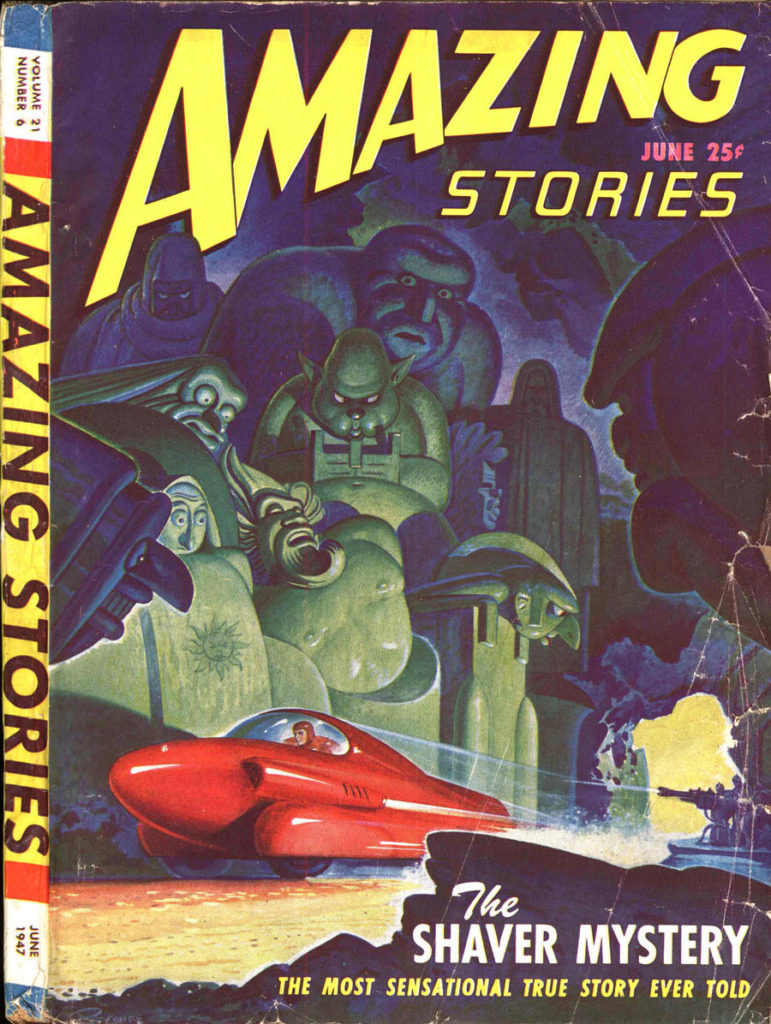I’m reading the manuscripts co-created by Ray Palmer and Richard Sharpe Shaver (1905-1977) that form the nucleus of The Shaver Mystery, a bit of twisty SF culture from the 40s and 50s that has long fascinated me. Shaver exhibited all the symptoms of classic schizophrenia, his first psychotic break coming in the early 30s:
As Bruce Lanier Wright notes, Shaver “began to notice that one of the welding guns on his job site, ‘by some freak of its coil’s field atunements’, was allowing him to hear the thoughts of the men working around him. More frighteningly, he then received the telepathic record of a torture session conducted by malign entities in caverns deep within the earth.”
Shaver suffers from a form of hallucination broadly known as The Influencing Machine, which has been a central shared myth of many schizophrenics since the first documented case, that of James Tilly Matthews.

Tilly described a world of futuristic machines, “magnetic spies” and mass brainwashing, woven into a bizarre but well-informed narrative of the high politics behind the Napoleonic Wars, in which Tilly played a very real role.
Seeking distraction from the madness of the present, I found a free ebook of I Remember Lumuria, the first of the Shaver Mystery texts attributed to Richard Shaver but mostly crafted by Palmer using the world building in his letter “A Warning to Future Man,” a 10,000 page outpouring of schizophrenic pseudo-science and paranoid delusion retrieved by Palmer from an editor’s trashcan.

While John W. Campbell strived for a degree of scientific rigor and literary quality in the pages of Astounding magazine, nurturing the seminal voices of the golden age of science fiction, Ray Palmer’s Amazing stories was more mercurial, adolescent, sensationalist…
In a word, I guess, deplorable.
Anyway, I’m halfway through I remember Lemuria, and have noted some recurring motifs of pseudo-scientific thought, including POE. Purity of Essence, the term given for General Jack D. Ripper’s vanished state of potency in Dr. Strangelove
In the shaver cult POE is invoked as the notion that the Earth’s sun has burned off its layer of ‘clean carbon’ 20,000 years in the past, and is now combusting dirtier, heavier elements, resulting in a constant wash of dirty particles which accumulate in our tissues. These accumulations cause aging, death, and disease, which are not natural. (old testament stories of giants and century-old patriarchs form a scaffolding for the Shaver Mystery, it seems.)
Shaver’s astrophysics is wrong, in ways understood even in the 40s; stars burn lighter elements (hydrogen, helium, etc0 by fusing them into heavier ones, with the heaviest elements being formed only in the heat and compression of supernovas. You know, the bit about all the iron in your blood having been formed in the explosion of a star? That’s true.
Shaver’s vision of the birth of our sun, in the atomic combustion of a dead planet’s fossil fuel layer, is wrong and ridiculous, but unlike John W. Campbell’s Astounding, Ray Palmer’s Amazing doesn’t care; the language of science is used as an incantation, a magic spell to induce the suspension of disbelief, and in the years following our destruction of Hiroshima and Nagasaki, the idea of nuclear poisons from our own sun raining down on us being responsible for all death and disease rang with a certain horrible truth.
If you’re interested in reading more about the Shaver Mystery, I found this article to be awesome, and googling it will give you links to other esoteric groups who believe in parts of the Shaver stories to this day.
Mysteriously, this article says it’s part one of a two part piece, but the second part is… missing. Attempts to leave a comment also generate an error… Gulp!
Why am I interested in this now?
For a time, the Shaver Mystery worked, vastly increasing the circulation of Amazing; Palmer would go on to found Fate magazine, an occult journal, but for a time Palmer and Shaver blurred the boundaries of science fiction and fact. The more respectable John W. Campbell would later follow suit, with his embrace of the Dean Drive and Scientology in the fifties and sixties, but his disregard for reality was never as flagrant as Palmer’s.
What we see in the Shaver mystery is the appeal of paranoid delusions to large groups of people. We see a huckster cynically milking the popular delusion of a sincere, but sick, man, and using it to enrich himself. A deranged manifesto in a trash-can is turned into a shared delusional world which infected hundreds of thousands of people, some who enjoyed it as entertainment, and other’s who took it seriously.
Traditional SF, its fandom and institution, scoffed at The Shaver Mystery, but that didn’t slow it’s explosive growth among the less sophisticated, the adolescent, the less educated, and the people attracted to the lurid sadism of the Deros, and the simplistic Manichean struggle between good and evil robot demons in vast caverns hidden beneath our feet.
I guess I’ve figured out why I’m drawn to Shaver and Palmer now.
I’m trying to figure out what story I want to tell with all this.
The story I need to tell.
Wish me luck… or a ray of inspiration from a Tero, one of the good ancient robots, buried deep in the stygian depth of the collective unconscious.

https://waterfallmagazine.com
I was curious if you ever thought of changing the
layout of your site? Its very well written; I
love what youve got to say. But maybe you could a little more in the way of
content so people could connect with it better.
Youve got an awful lot of text for only having
one or 2 images. Maybe you could space it out better?
More illustrations you mean? Pull quotes, subheads? Yeah. Good ideas. I spend a ton of time on Facebook spewing politics and memoire and I always feel guilty doing any writing but fiction, which I do spend the time to craft and clean up and polish. I produce very typo-ridden prose that takes a ton of clean-up. Some weird brain thing. The idea here was to take all that pointless verbiage and try to construct something around my fiction so that it could have some business purpose, but I think I’ve made about 100 dollars and spent over the years 1000 on the domain name, so, you know. Sigh.